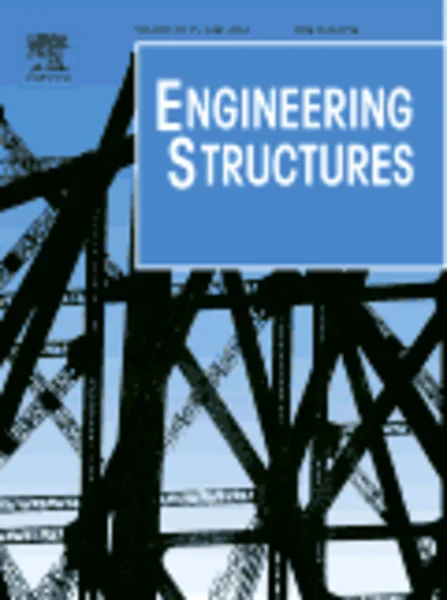-
random vibration of a train traversing a bridge subjected to traveling seismic waves
جزئیات بیشتر مقاله- تاریخ ارائه: 1392/07/24
- تاریخ انتشار در تی پی بین: 1392/07/24
- تعداد بازدید: 917
- تعداد پرسش و پاسخ ها: 0
- شماره تماس دبیرخانه رویداد: -
non-stationary random vibration of 3d time-dependent train–bridge systems subjected to multi-point earthquake excitations, including wave passage effect, is investigated using the pseudo-excitation method (pem). the motion equation of such a system is established by coupling the train and bridge through wheel–rail contact relationships and accounting for the phase-lags between pier excitations. the horizontal and vertical earthquake excitations are both assumed to be uniformly modulated, fully coherent random excitations with different phases, while the excitation due to track irregularities is assumed to be a 3d, fully coherent random excitation with velocity-dependent time lags. pem is first proven to be applicable to such time-dependent systems, and is then used to transform the random excitations into a series of deterministic pseudo excitations. by solving for the corresponding deterministic pseudo responses, various non-stationary random responses, including the time-dependent power spectral density functions (psd) and standard deviations (sd), can be obtained easily. a case study is then presented in which the china-star high-speed train traverses a seven-span continuous bridge that is being excited by an earthquake. the results show the effectiveness and accuracy of the proposed method by comparison with a monte carlo simulation. additionally, the influences of seismic apparent wave velocity and train speed on the system random responses are discussed.
مقالات جدیدترین رویدادها
-
استفاده از تحلیل اهمیت-عملکرد در ارائه الگوی مدیریت خلاقیت سازمانی و ارائه راهکار جهت بهبود
-
بررسی تاثیر ارزش وجوه نقد مازاد بر ساختار سرمایه شرکت های پذیرفته شده در بورس اوراق بهادار تهران
-
بررسی تأثیر سطح افشای ریسک بر قرارداد بدهی شرکت های پذیرفته شده در بورس اوراق بهادار تهران
-
بررسی تأثیر رتبه بندی اعتباری مبتنی بر مدل امتیاز بازار نوظهور بر نقد شوندگی سهام با تأکید بر خصوصی سازی شرکت ها
-
تأثیر آمیخته بازاریابی پوشاک ایرانی بر تصویر ذهنی مشتری پوشاک ایرانی (هاکوپیان)
-
بررسی رابطه بین اعتیاد به اینترنت و سواد اطلاعاتی دانشجویان تحصیلات تکمیلی دانشگاه پیام نور (مطالعه موردی: خراسان رضوی مرکز مشهد)
-
بررسی اثر افزایش نسبت طول به عرض پایه های مستطیلی دماغه گرد بر توسعه ی زمانی آب شستگی موضعی پایه با شمع های حفاظتی
-
ضرورت وجود مجموعه گردشگری و توریستی جوانان با توجه به هویت طبیعی و تاریخی شهر زنجان
-
شناسایی و رتبه بندی عوامل موثر بر برندسازی کسب و کارهای کوچک و متوسط (sme) با استفاده از روش ترکیبی دیمتل و فرایند تحلیل شبکه ای (anp)
-
on cone metric spaces: a survey
مقالات جدیدترین ژورنال ها
-
مدیریت و بررسی افسردگی دانش آموزان دختر مقطع متوسطه دوم در دروان کرونا در شهرستان دزفول
-
مدیریت و بررسی خرد سیاسی در اندیشه ی فردوسی در ادب ایران
-
واکاوی و مدیریت توصیفی قلمدان(جاکلیدی)ضریح در موزه آستان قدس رضوی
-
بررسی تاثیر خلاقیت، دانش و انگیزه کارکنان بر پیشنهادات نوآورانه کارکنان ( مورد مطالعه: هتل های 3 و 4 ستاره استان کرمان)
-
بررسی تاثیر کیفیت سیستم های اطلاعاتی بر تصمیم گیری موفق در شرکتهای تولیدی استان اصفهان (مورد مطالعه: مدیران شرکتهای تولیدی استان اصفهان)
-
تحقق اهداف پدافند غیرعامل درکاربری های آموزشی با تاکید بر طراحی فضاهای باز
-
عملکرد نظام حقوقی ایران در مواجهه با جرایم سازمان یافته
-
بررسی راه های جذب توریسم روستایی بر اساس مدل swot و اثرات گردشگری بر توسعه پایدار روستایی (مطالعه موردی روستاهای داش دیبی و شوئون شهرستان گرمی)
-
evaluation the educational quality performance of islamic azad university, karaj branch, based on kirkpatrick’s model
-
a comparative study on the flexural behaviour of rubberized and hybrid rubberized reinforced concrete beams




سوال خود را در مورد این مقاله مطرح نمایید :